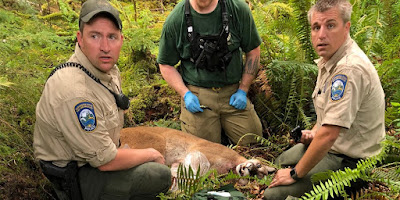For over two decades, my students were involved in "service-learning" projects. Service-learning goes by a number of monikers, but I like this label. It links learning explicitly with community engagement. For 5 years, I was USU's Service-Learning Coordinator, and I used service-learning to get, as scholar Barbara Jacoby wrote, "... students engaged in activities that address human and community needs together with structured opportunities for reflection designed to achieve desired learning outcomes."
My primary service-learning (SL) course was ENVS 3600, Living with Wildlife, although I taught other SL courses as well. The syllabus provided this information to students:
Service-learning is an educational experience for students that meets community needs while assisting students with gaining a better understanding of the course content. It puts the course content into perspective in ways that cannot be accomplished in the classroom.
You will also have to reflect on the service-learning experience. In your project reflections, think of discussing these issues: What? So what? And now what? What did you do, and why? What was the relevance, utility, and importance of this project? How will this affect your future interactions with people and wildlife?
Here are some examples of SL projects In my courses over the years.
 |
| Recycling for ENVS 2000 (with Katlin Carey, far right) |
 |
| Tree planting, Spring Break Service Trip, Honolulu (Jordan Hunt, planter). |
 |
| Taro patch preparation, Spring Break Service Trip, Honolulu. |
 |
| Beach clean-up, Spring Break Service Trip, Honolulu (Varuna Ponnamperuma). |
 |
| Blake Thomas staffing a Seafood Watch table at USU. |
 |
| University of Hawaii students planning for an analysis of the hunter education program in Hawaii. |
 
|
| University of Hawaii students conducting walk-up surveys on feral cat management in Hawaii Kai, Oahu. |
 |
Bat nursery box built by Mark Hancock, and installed at Zootah.
|
 |
| One year I had students volunteer at Aggie Blue Bikes, since our community transport systems have profound impacts on wildlife habitat. ABB was Service-Learning Scholar Adam Christensen's capstone project. |
 |
| ENVS 3600 students trimming Logan's street trees. These trees are critical wildlife habitat in urban areas. |
 |
| Twice, my students made presentation to Logan's Parks and Recreation Advisory Committee regarding risks from mountain lions. This is the signage from Ronald W. Caspers Wilderness Park in Orange County, California, the site of a lion attack on a 5 year old girl in 1986. |
 |
On multiple occasions, ENVS 5000 students volunteered at the Cache Humane Society.
|
 |
| Planting trees in Logan Canyon for Logan Parks and Recreation. |
 |
| Jordan Risley capturing a lost ducking during the tree planting project. |
I had 3 ENVS 3600 cohorts make bird houses, all donated to the City of Nibley for their parks. Delena Williams (above, right) was both a student and a teaching assistant for these efforts.
 |
| Sarah Woodbury on the left! |
We made 50+ bat roosting boxes, all donated to the Utah Division of Wildlife Resources.
 |
| I worked with the Full Circle and Velociti Dance Companies, under the direction of Krissy Fry, to make sure they got credit for their service to the community. |
And none of this wouldn't have happened without fabulous partners, including Nelene Howard Stevens, Juan Franco, Julie Koldewyn, Sheldon Browning, Tiffany Evans, and Lisa Hollingsworth Vaughn.
 |
| Then, 2020. Covid-19 and retirement! |






























Comments
Post a Comment